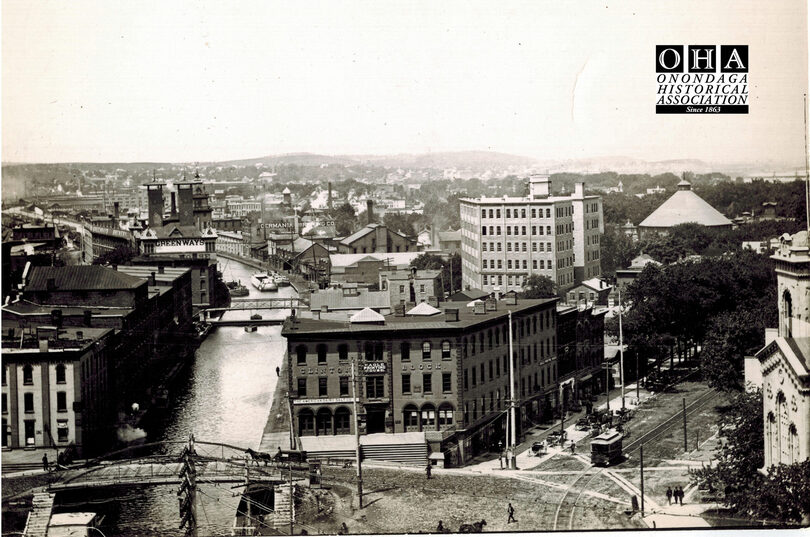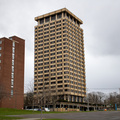Erie Canal’s bicentennial commemorates waterway’s history of ‘harm’

“We’re very well aware that the canal has and continues to cause lots of various forms of harm.” The Erie Canal Bicentennial will end this year, commemorating the canal’s history of displacing communities, including the Haudenosaunee. Courtesy of Onondaga Historical Association
Get the latest Syracuse news delivered right to your inbox.
Subscribe to our newsletter here.
Despite the Erie Canal’s long history of connecting the United States and its strong ties to Syracuse, Robert Searing said the harm its construction caused is still tangible throughout the city.
“Everything. The industry, Syracuse University, it’s all in one way or another connected to the canal and to the salt business,” Searing, Onondaga Historical Association’s curator of history, said. “As a city historian, I see legacies of the canal everywhere, throughout the city.”
The Erie Canal Bicentennial period, an eight-year-long commemoration of the 200th anniversary of the canal’s completion, began in 2017 and will end this year. It remembers the period between 1817 and 1825 when the canal was originally constructed. The Onondaga Historical Association and Erie Canal Museum hosted a bicentennial gala last Friday.
In Syracuse, the Erie Canal was filled in and turned into Erie Boulevard less than 100 years after it was completed. Searing said the canal’s legacy lingers in Syracuse today.
When the Erie Canal was completed in 1825, the population of Syracuse grew from 250 to 30,000 in just a few decades, Searing said. Because of the canal, the city saw growth in major trade and industry, such as salt production and brewing.
Industries were still growing in 1870, when Syracuse University was founded. George Comstock, an original SU trustee, was involved in the salt business in Syracuse.
Despite the Erie Canal’s key role in the city and SU’s history, Steph Adams, an interpretation coordinator at the Erie Canal Museum, said the bicentennial is a commemoration, not a celebration.
“Celebrating leaves the connotation that this is entirely a good thing, and we’re very well aware that the canal has and continues to cause lots of various forms of harm,” they said.
Some of that harm is still apparent on maps today. Major infrastructure has always separated the city, Searing said. Whether it’s the canal, the railroads or the I-81 interstate, a new public works project seems to occur every generation, he said.
“If you overlay a map of the redlined districts over a map of Syracuse with the canal, and then you overlay the map of Syracuse with the highways, it’s all connected,” Adams said.
They said the correlation between the interstate and the canal was set before Syracuse even became a city.
As the development of Syracuse surrounded the canal, the buildings closest to it are some of the oldest and least cared for, and often where immigrant and minority communities ended up, Adams said.
“The historical legacy of that, is that is where the 15th Ward is situated, even though the canal is gone, everything’s been set in motion for where those neighborhoods are going to be,” Adams said.
I-81 and the canal are only separated by about 30 years of history; the canal was filled in the 1920s and planning for the highway began in the 1950s.
Construction of the I-81 exaggerated segregation in Syracuse as the highway only ran through yellow and red-coded districts of the city. The highway split apart the historic 15th Ward, where nearly 90% of Syracuse’s Black population lived.
Haudenosaunee communities were also significantly damaged by the construction of the canal— a history of dispossession that extends back to the Revolutionary War, said Emerson Shenandoah, member of the Onondaga snipe clan and director of the Skä•noñh – Great Law of Peace Center. Shenandoah said the Haudenosaunee people hold a “bad ill feeling” toward the canal, which he refers to as “Clinton’s ditch.”
During and after the Revolutionary War, the Haudenosaunee held a lot of influence due to their geographical position in a vital trade route, Shenandoah said. European leaders grew tired of compromising with the Haudenosaunee and planned the Clinton-Sullivan Campaign in 1779.
The campaign tore through Haudenosaunee homelands, burning villages and crops to make way for the settlement of Revolutionary War soldiers who were promised land parcels as a reward for fighting, Shenandoah said. He said the campaign tried to weaken the Haudenosaunee, clearing the territory through mass displacement and allowing for the canal’s construction.
“Two things can be true at the same time,” Searing said. “The Erie Canal is a revolutionary engineering marvel and what it does for the United States in terms of advancing the country’s wealth and prosperity is hard to overstate. At the same time, the devastation that the construction of the canal wrought on Haudenosaunee homelands is also a big part of the story.”
The Haudenosaunee never got to benefit from the economic boost the canal created, Shenandoah said, instead losing their economic power as they lost their monopoly on the fur trade. When the canal was completed in 1825, the Haudenosaunee still hadn’t been offered citizenship.
Today, money made off of the land stolen during that time still doesn’t benefit the Haudenosaunee, Shenandoah said.
“All of the property taxes that are accumulated every year on stolen land is money they’re making off our backs,” Shenandoah said. “The natural resources and property taxes they extract from these lands could have been ours.”
Some people tend to “romanticize” the Erie Canal, picturing memories of Clinton Square busy with commerce and activities, Searing said. Those images don’t include some of the less picturesque parts of the canal, as it was at times a public nuisance and safety hazard.
Sanitation workers often threw garbage into the canal, along with sewage and dead animals. The water was “smelly,” Adams said.
Syracuse’s reputation as a Rust Belt city also ties into the sentimentalization of the canal, they said. The canal brought a lot of industry to Syracuse, but a century later, the city began experiencing deindustrialization.
“It’s tricky because there’s a lot of industrial nostalgia tied up in Erie Canal tourism, without really reckoning with the fact that a lot of our communities have been decimated by when these industries left,” Adams said.
Now, Syracuse has the opportunity to undo some of the harm the canal has caused, Searing said.
The I-81 viaduct removal project plans to demolish the highway and reconnect the split 15th Ward. The viaduct represents another generation of public works projects changing the city’s landscape, Searing said, with potential to be a “wonderfully positive” development for Syracuse’s downtown.
Some are even calling Micron’s arrival Syracuse’s “next Erie Canal moment,” Adams said. They said moving forward into a new era of industry is all about balance. Talking about the canal can be an entry point to topics like colonialism, capitalism, the Land Back Movement and environmental degradation, but it’s hard to spread awareness without causing people to “run away screaming,” Adams said.
Shenandoah said more comprehensive education in New York state is the only path forward he sees. When he learned about the Erie Canal in school, he remembers being told that the Haudenosaunee people peacefully moved out of the way, without any mention of the Clinton-Sullivan Campaign.
“We have to find a way to collectively process the good, the bad and the ugly of history, and not in a way that is too partisan,” Adams said. “Somehow there has to be a way to have these conversations more broadly.”






